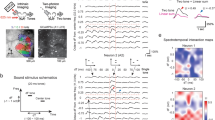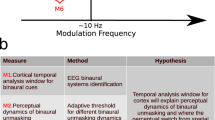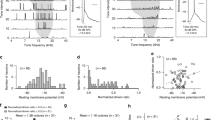Abstract
Sound localization critically depends on detection of differences in arrival time of sounds at the two ears (acoustic delay). The fundamental mechanisms are debated, but all proposals include a process of coincidence detection and a separate source of internal delay that offsets the acoustic delay and determines neural tuning. We used in vivo patch-clamp recordings of binaural neurons in the Mongolian gerbil and pharmacological manipulations to directly compare neuronal input to output and to separate excitation from inhibition. Our results cannot be accounted for by existing models and reveal that coincidence detection is not an instantaneous process, but is instead shaped by the interaction of intrinsic conductances with preceding synaptic activity. This interaction generates an internal delay as an intrinsic part of the process of coincidence detection. The multiplication and time-shifting stages thought to extract synchronous activity in many brain areas can therefore be combined in a single operation.
This is a preview of subscription content, access via your institution
Access options
Subscribe to this journal
Receive 12 print issues and online access
$209.00 per year
only $17.42 per issue
Buy this article
- Purchase on Springer Link
- Instant access to full article PDF
Prices may be subject to local taxes which are calculated during checkout







Similar content being viewed by others
References
Joris, P. & Yin, T.C. A matter of time: internal delays in binaural processing. Trends Neurosci. 30, 70–78 (2007).
Herz, A.V., Gollisch, T., Machens, C.K. & Jaeger, D. Modeling single-neuron dynamics and computations: a balance of detail and abstraction. Science 314, 80–85 (2006).
Ashida, G. & Carr, C.E. Sound localization: Jeffress and beyond. Curr. Opin. Neurobiol. 21, 745–751 (2011).
Cant, N.B. & Hyson, R.L. Projections from the lateral nucleus of the trapezoid body to the medial superior olivary nucleus in the gerbil. Hear. Res. 58, 26–34 (1992).
Buzsáki, G., Logothetis, N. & Singer, W. Scaling brain size, keeping timing: evolutionary preservation of brain rhythms. Neuron 80, 751–764 (2013).
Brette, R. Computing with neural synchrony. PLoS Comput. Biol. 8, e1002561 (2012).
Klumpp, R. & Eady, H. Some measurements of interaural time differences thresholds. J. Acoust. Soc. Am. 28, 859–864 (1956).
van der Heijden, M. et al. Directional hearing by linear summation of binaural inputs at the medial superior olive. Neuron 78, 936–948 (2013).
Roberts, M.T., Seeman, S.C. & Golding, N.L. A mechanistic understanding of the role of feedforward inhibition in the mammalian sound localization circuitry. Neuron 78, 923–935 (2013).
Brand, A., Behrend, O., Marquardt, T., McAlpine, D. & Grothe, B. Precise inhibition is essential for microsecond interaural time difference coding. Nature 417, 543–547 (2002).
Jeffress, L.A. A place theory of sound localization. J. Comp. Physiol. Psychol. 41, 35–39 (1948).
Hyson, R.L. The analysis of interaural time differences in the chick brain stem. Physiol. Behav. 86, 297–305 (2005).
Yin, T.C.T. & Chan, J.K. Interaural time sensitivity in medial superior olive of cat. J. Neurophysiol. 64, 465–488 (1990).
Goldberg, J.M. & Brown, P.B. Response of binaural neurons of dog superior olivary complex to dichotic tonal stimuli: some physiological mechanisms of sound localization. J. Neurophysiol. 32, 613–636 (1969).
Smith, P.H., Joris, P.X. & Yin, T.C.T. Projections of physiologically characterized spherical bushy cell axons from the cochlear nucleus of the cat: evidence for delay lines to the medial superior olive. J. Comp. Neurol. 331, 245–260 (1993).
Beckius, G.E., Batra, R. & Oliver, D.L. Axons from anteroventral cochlear nucleus that terminate in medial superior olive of cat: observations related to delay lines. J. Neurosci. 19, 3146–3161 (1999).
McAlpine, D. & Grothe, B. Sound localization and delay lines—do mammals fit the model? Trends Neurosci. 26, 347–350 (2003).
Karino, S., Smith, P.H., Yin, T.C.T. & Joris, P.X. Axonal branching patterns as sources of delay in the mammalian auditory brainstem: a re-examination. J. Neurosci. 31, 3016–3031 (2011).
Pecka, M., Brand, A., Behrend, O. & Grothe, B. Interaural time difference processing in the mammalian medial superior olive: the role of glycinergic inhibition. J. Neurosci. 28, 6914–6925 (2008).
Jercog, P.E., Svirskis, G., Kotak, V.C., Sanes, D.H. & Rinzel, J. Asymmetric excitatory synaptic dynamics underlie interaural time difference processing in the auditory system. PLoS Biol. 8, e1000406 (2010).
Zhou, Y., Carney, L.H. & Colburn, H.S. A model for interaural time difference sensitivity in the medial superior olive: interaction of excitatory and inhibitory synaptic inputs, channel dynamics, and cellular morphology. J. Neurosci. 25, 3046–3058 (2005).
Shamma, S.A. Stereausis: binaural processing without neural delays. J. Acoust. Soc. Am. 86, 989–1006 (1989).
Joris, P.X., van de Sande, B., Louage, D.H. & van der Heijden, M. Binaural and cochlear disparities. Proc. Natl. Acad. Sci. USA 103, 12917–12922 (2006).
Scott, L.L., Mathews, P.J. & Golding, N.L. Posthearing developmental refinement of temporal processing in principal neurons of the medial superior olive. J. Neurosci. 25, 7887–7895 (2005).
Myoga, M.H., Lehnert, S., Leibold, C., Felmy, F. & Grothe, B. Glycinergic inhibition tunes coincidence detection in the auditory brainstem. Nat. Commun. 5, 3790 (2014).
Stotler, W.A. An experimental study of the cells and connections of the superior olivary complex of the cat. J. Comp. Neurol. 98, 401–431 (1953).
Smith, P.H. Structural and functional differences distinguish principal from nonprincipal cells in the guinea pig MSO slice. J. Neurophysiol. 73, 1653–1667 (1995).
Guinan, J.J., Norris, B.E. & Guinan, S.S. Single auditory units in the superior olivary complex. II. Locations of unit categories and tonotopic organization. Int. J. Neurosci. 4, 147–166 (1972).
Maki, K. & Furukawa, S. Acoustical cues for sound localization by the Mongolian gerbil, Meriones unguiculatus. J. Acoust. Soc. Am. 118, 872–886 (2005).
Betz, H. & Becker, C.M. The mammalian glycine receptor: biology and structure of a neuronal chloride channel protein. Neurochem. Int. 13, 137–146 (1988).
Khurana, S. et al. An essential role for modulation of hyperpolarization-activated current in the development of binaural temporal precision. J. Neurosci. 32, 2814–2823 (2012).
Mathews, P.J., Jercog, P.E., Rinzel, J., Scott, L.L. & Golding, N.L. Control of submillisecond synaptic timing in binaural coincidence detectors by K(v)1 channels. Nat. Neurosci. 13, 601–609 (2010).
Colburn, H.S. Theory of binaural interaction based on auditory-nerve data. II. Detection of tones in noise. J. Acoust. Soc. Am. 61, 525–533 (1977).
Batra, R., Kuwada, S. & Fitzpatrick, D.C. Sensitivity to interaural temporal disparities of low- and high-frequency neurons in the superior olivary complex. II. Coincidence detection. J. Neurophysiol. 78, 1237–1247 (1997).
Svirskis, G., Kotak, V., Sanes, D.H. & Rinzel, J. Enhancement of signal-to-noise ratio and phase locking for small inputs by a low-threshold outward current in auditory neurons. J. Neurosci. 22, 11019–11025 (2002).
Svirskis, G., Kotak, V., Sanes, D.H. & Rinzel, J. Sodium along with low-threshold potassium currents enhance coincidence detection of subthreshold noisy signals in MSO neurons. J. Neurophysiol. 91, 2465–2473 (2004).
Scott, L.L., Mathews, P.J. & Golding, N.L. Perisomatic voltage-gated sodium channels actively maintain linear synaptic integration in principal neurons of the medial superior olive. J. Neurosci. 30, 2039–2050 (2010).
Golding, N.L., Ferragamo, M.J. & Oertel, D. Role of intrinsic conductances underlying responses to transients in octopus cells of the cochlear nucleus. J. Neurosci. 19, 2897–2905 (1999).
Ohlemiller, K.K. & Echteler, S.M. Functional correlates of characteristic frequency in single cochlear nerve fibers of the Mongolian gerbil. J. Comp. Physiol. A 167, 329–338 (1990).
Couchman, K., Grothe, B. & Felmy, F. Medial superior olivary neurons receive surprisingly few excitatory and inhibitory inputs with balanced strength and short-term dynamics. J. Neurosci. 30, 17111–17121 (2010).
Franken, T.P., Bremen, P. & Joris, P.X. Coincidence detection in the medial superior olive: mechanistic implications of an analysis of input spiking patterns. Front. Neural Circuits 8, 42 (2014).
Funabiki, K., Ashida, G. & Konishi, M. Computation of interaural time difference in the owl's coincidence detector neurons. J. Neurosci. 31, 15245–15256 (2011).
McAlpine, D., Jiang, D. & Palmer, A. A neural code for low-frequency sound localization in mammals. Nat. Neurosci. 4, 396–401 (2001).
Goodman, D.F., Benichoux, V. & Brette, R. Decoding neural responses to temporal cues for sound localization. eLife 2, e01312 (2013).
Day, M.L. & Delgutte, B. Decoding sound source location and separation using neural population activity patterns. J. Neurosci. 33, 15837–15847 (2013).
Day, M.L. & Semple, M.N. Frequency-dependent interaural delays in the medial superior olive: implications for interaural cochlear delays. J. Neurophysiol. 106, 1985–1999 (2011).
Bremen, P. & Joris, P.X. Axonal recordings from medial superior olive neurons obtained from the lateral lemniscus of the chinchilla (Chinchilla laniger). J. Neurosci. 33, 17506–17518 (2013).
McAlpine, D., Jiang, D. & Palmer, A. Interaural delay sensitivity and the classification of low best-frequency binaural responses in the inferior colliculus of the guinea pig. Hear. Res. 97, 136–152 (1996).
Stuart, G.J. & Häusser, M. Dendritic coincidence detection of EPSPs and action potentials. Nat. Neurosci. 4, 63–71 (2001).
Larkum, M.E., Zhu, J.J. & Sakmann, B. A new cellular mechanism for coupling inputs arriving at different cortical layers. Nature 398, 338–341 (1999).
Rautenberg, P.L., Grothe, B. & Felmy, F. Quantification of the three-dimensional morphology of coincidence detector neurons in the medial superior olive of gerbils during late postnatal development. J. Comp. Neurol. 517, 385–396 (2009).
Magnusson, A.K., Kapfer, C., Grothe, B. & Koch, U. Maturation of glycinergic inhibition in the gerbil medial superior olive after hearing onset. J. Physiol. (Lond.) 568, 497–512 (2005).
Margrie, T.W., Brecht, M. & Sakmann, B. In vivo, low-resistance, whole-cell recordings from neurons in the anaesthetized and awake mammalian brain. Pflugers Arch. 444, 491–498 (2002).
Citi, L. et al. On the use of wavelet denoising and spike sorting techniques to process electroneurographic signals recorded using intraneural electrodes. J. Neurosci. Methods 172, 294–302 (2008).
Acknowledgements
We thank P.H. Smith for the camera lucida drawings shown in Figure 2a and for feedback on the manuscript. We thank M. Brecht, N. Priebe and S. Agarwala for discussions and advice. This work was supported by a Ph. D. fellowship of the Research Foundation-Flanders (FWO) to T.P.F., project grants from FWO (G.0714.09, G.0961.11) and Research Fund KU Leuven (OT/09/50) to P.X.J., and US National Institutes of Health grants DC011403 (N.L.G. and P.X.J.) and DC006788 (N.L.G.).
Author information
Authors and Affiliations
Contributions
T.P.F. performed the in vivo experiments and analyzed the data. T.P.F., M.T.R., N.L.G. and P.X.J. developed in vivo patch-clamping methods. M.T.R. performed in vitro experiments and analyzed the data. T.P.F. and L.W. performed histological processing. T.P.F., M.T.R., N.L.G. and P.X.J. designed the study and wrote the manuscript.
Corresponding author
Ethics declarations
Competing interests
The authors declare no competing financial interests.
Integrated supplementary information
Supplementary Figure 1 Shift of ITD tuning is observed with different methods of prediction.
(a) rITDfs and predITDfs corresponding to a positive and negative binaural beat (resp. ipsi/contra stimulus frequency 300 Hz/301 Hz and 300 Hz/299 Hz). Shift is unrelated to the sign of the binaural beat. This shows that the shift is dependent on ITD and excludes a dynamic artifact of the stimulus. Characteristic frequency = 4.6 kHz. (b) PredITDf for different prediction threshold values. Black line is rITDf. Stimulus: 300/301 Hz 70 dB (characteristic frequency = 1895 Hz). (c) Difference between BD of rITDf and predITDfs from b as a function of threshold. Predicted BD is not dependent on threshold. (d,e) ITD function is compared with the monaural prediction for two datasets. PredITDf is similar whether the complete monaural responses are summed and then thresholded (solid red line; as in Fig. 3), or the monaural EPSP period histograms are crosscorrelated (dashed red line). The latter method of prediction uses only the timing of the EPSP peaks and diminishes the weight of the amplitude differences between EPSPs, and ignores other aspects of the monaural input, such as hyperpolarizing events. Stimulus 400/401 Hz 70 dB (d) and 400/401 Hz 80 dB (e). Characteristic frequencies: 1741 Hz (d) and 1149 Hz (e). (f) Comparison of shift for both methods of prediction as in d and e at the population level. Only datasets with significant suprathreshold ITD tuning were included (Rayleigh test α <= 0.001). Symbols correspond to Figure 3b,d. Dashed line is linear fit (linear correlation; t(56) = 6.23; 58 datasets from 24 neurons).
Supplementary Figure 2 Individual traces preceding supraEPSPs and subEPSPs for ITDs with the same supraEPSP rate.
ITD1 and ITD2 as indicated in Figure 6a. Rows correspond to the datasets in Figure 6a-c. Data traces are aligned at the peak of the first derivative of the EPSP. In the datasets with a shift (top two rows), subEPSPs are preceded more frequently by smaller EPSPs (arrows), corresponding to the relative depolarization in Figure 6b.
Supplementary Figure 3 Leading depolarization hinders spiking in response to broadband noise.
(a-h) SupraEPSPs (black) and subEPSPs (red) are stacked for eight MSO neurons during binaural stimulation with broadband noise. Events were aligned on the peak of the first derivative of the EPSP. Responses were pooled across binaural conditions (e.g. different ITDs, correlated and uncorrelated noise). Right panels show the averages for supraEPSPs (black) and subEPSPs (red) separately. As for stimulation with tones, preceding relative depolarizations are associated with spike failures. CF is indicated in the right panels when known. (i) Average Vm preceding subEPSPs and supraEPSPs 1 to 0.5 ms before the maximum of the first derivative of the EPSP for the neurons in a-h. Grey lines connect individual values. Red and black lines are population averages. Significance was assessed using a one-tailed paired t-test (t(7) = 7.46). Characteristic frequency is indicated in panels a-h when known.
Supplementary Figure 4 Shift relative to preceding depolarizations 0.7 to 0.5 ms before the main EPSP peak.
There was no significant correlation between the shift and the ratio of preceding EPSPs 0.5 to 0.7 ms before the main EPSP, consistent with the effect of timing in the dynamic clamp experiments (Fig. 7f). Linear correlation (t(69) = 1.16; 71 datasets from 28 neurons)
Supplementary Figure 5 Coincidence detection in mammalian sound localization is adaptive rather than instantaneous.
(a) Left, scheme of instantaneous coincidence detection. Output results directly from events coinciding within a narrow time window (coincidence window, cw). Right, adaptive coincidence detection takes into account preceding EPSPs and is not simply predicted by coincidence of events in the coincidence window. (b) Top two rows: cycle histograms for symmetrical (first row) and asymmetrical (second row) inputs at different ITDs. Bottom: ITD functions corresponding to symmetrical inputs (black), instantaneous coincidence detection for asymmetrical inputs (dashed red line) and adaptive coincidence detection for asymmetrical inputs (solid red line). For the asymmetrical inputs, the contralateral ear evokes fewer early EPSPs. With instantaneous coincidence detection this shifts the ITD curve to the right, favoring sounds that arrive at the contralateral ear first. With adaptive coincidence detection, the small group of leading EPSPs in the contralateral input decrease spiking when sounds arrive at the contralateral ear first, thereby shifting the ITD curve to the left.
Supplementary information
Supplementary Text and Figures
Supplementary Figures 1–5 (PDF 1426 kb)
Rights and permissions
About this article
Cite this article
Franken, T., Roberts, M., Wei, L. et al. In vivo coincidence detection in mammalian sound localization generates phase delays. Nat Neurosci 18, 444–452 (2015). https://doi.org/10.1038/nn.3948
Received:
Accepted:
Published:
Issue Date:
DOI: https://doi.org/10.1038/nn.3948
This article is cited by
-
Effective sound detection system in commercial car vehicles using Msp430 launchpad development
Multimedia Tools and Applications (2023)
-
Structure and dynamics that specialize neurons for high-frequency coincidence detection in the barn owl nucleus laminaris
Biological Cybernetics (2023)
-
Dynamics of interaction between IH and IKLT currents to mediate double resonances of medial superior olive neurons related to sound localization
Cognitive Neurodynamics (2023)
-
Geometric characterization of dynamical structure for neural firing activities induced by inhibitory pulse
Cognitive Neurodynamics (2022)
-
Auditory Brainstem Models: Adapting Cochlear Nuclei Improve Spatial Encoding by the Medial Superior Olive in Reverberation
Journal of the Association for Research in Otolaryngology (2021)



